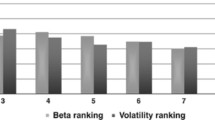Abstract
Our purpose in this article is to investigate the benefits of introducing quantitative strategies for the estimation of portfolio variance–covariance matrices, expecting that the stylized facts of asset returns and their economic impact will be effectively captured. More specifically, we are dealing with the process of portfolio optimization with rebalancing for ETFs portfolios, in a time-varying volatility environment. The aim of the analysis is to construct optimal portfolios, based on the econometric modelling and calculation of return covariances. Also, our target is to infer critical comparative insights, as far as the application of three popular quantitative frames: (a) the sample covariance or equal weighting model, (b) the EWMA model, and (c) the GARCH (1,1) model. The validity of the attempt is verified through an illustrative empirical testing procedure on an actively traded low-volatility momentum mutual fund-of-ETFs, consisting of a well-diversified investment universe of 150 ETFs. Additionally, we co-assess a set of non-convex investment policy restrictions, such as buy-in thresholds and compliance norms, modelling the corresponding portfolio selection process as a mixed-integer optimization problem. The qualitative and technical conclusions obtained, document superior out-of-sample returns for the portfolios constructed by means of the EWMA and GARCH (1,1) models. Moreover, other findings that confirm and expand the existing underlying research, are also reported.


Similar content being viewed by others
References
Adcock, C., & Meade, N. (1994). A simple algorithm to incorporate transaction costs in quadratic optimization. European Journal of Operational Research,79(1), 85–94.
Alexander, C. (2008). Practical financial econometrics: Market risk analysis (Vol. II). Hoboken: Wiley.
Arshanapalli, B., Coggin, T., & Nelson, W. (2001). Is fixed-weight asset allocation really better. The Journal of Portfolio Management,27, 27–38.
Bollerslev, T. (1986). Generalised autoregressive conditional heteroscedasticity. Journal of Econometrics,31, 307–327.
Brinson, G., Singer, B., & Beebower, G. (1991). Determinants of portfolio performance II: An update. Financial Analysts Journal,47(3), 40–48.
Brooks, C., Burke, S., & Persand, G. (2003). Multivariate GARCH models: Software choice and estimation issues. Journal of Applied Econometrics,18, 725–734.
Brown, D., & Smith, J. (2011). Dynamic portfolio optimization with transaction costs: Heuristics and dual bounds. Management Science,57(10), 1752–1770.
DeMiguel, V., Garlappi, L., & Uppal, R. (2009). Optimal versus naive diversification: How inefficient is the 1/N portfolio strategy? The Review of Financial Studies,22, 1915–1953.
Dickson, J., Kwon, D., & Rowley, J. (2015). Choosing between ETFs and mutual funds: Strategy, then structure. Valley Forge: The Vanguard Group.
Engle, R. (1982). Autoregressive conditional heteroscedasticity with estimates of the variance of United Kingdom inflation. Econometrica,50, 987–1007.
Fabozzi, F., Focardi, S., & Jonas, C. (2007). Trends in quantitative equity management: Survey results. Quantitative Finance,7, 115–122.
Fabozzi, F., Huang, D., & Zhou, G. (2010). Robust portfolios: Contributions from operations research and finance. Annals of Operations Research,176, 191–220.
Ibbotson, R., & Kaplan, P. (2000). Does asset allocation policy explain 40, 90, or 100 percent of performance? Financial Analysts Journal,56(1), 26–33.
Ledoit, O., & Wolf, M. (2003). Improved estimation of the covariance matrix of stock returns with an application to portfolio selection. Journal of Empirical Finance,10, 603–629.
Leland, H. (1999). Beyond mean-variance: Performance measurement in a non-symmetrical World. Financial Analysts Journal,55, 27–36.
Maginn, J., Tuttle, D., Pinto, D., & McLeavey, D. (2007). Managing investment portfolios (3rd ed.). New York: Wiley.
Markowitz, H. (1952). Portfolio selection. The Journal of Finance,7(1), 77–91.
Markowitz, H. (1956). The optimization of a quadratic function subject to linear constraints. Naval Research Logistics Quarterly,3, 111–133.
Moallemi, C., & Saglam, M. (2017). Dynamic portfolio choice with linear rebalancing rules. Journal of Financial and Quantitative Analysis,52(3), 1247–1278.
Morgan, J. P. (1996). RiskMetrics™ technical document. http://www.riskmetrics.com/rmcovv.html. Accessed Nov 2014.
Wallick, D., Shanahan, J., Tasopoulos, C., & Yoon, J. (2012). The global case for strategic asset allocation. Valley Forge: The Vanguard Group.
Xidonas, P., & Mavrotas, G. (2014a). Multiobjective portfolio optimization with non-convex policy constraints: Evidence from the Eurostoxx 50. European Journal of Finance,20(11), 957–977.
Xidonas, P., & Mavrotas, G. (2014b). Comparative issues between linear and non-linear risk measures for non-convex portfolio optimization: Evidence from the S&P 500. Quantitative Finance,14(7), 1229–1242.
Xidonas, P., Mavrotas, G., Zopounidis, C., & Psarras, J. (2011). IPSSIS: An integrated multicriteria DSS for equity portfolio construction and selection. European Journal of Operational Research,210(2), 398–409.
Zilbering, Y., Jaconetti, C., & Kinniry, F. (2015). Best practices for portfolio rebalancing. Valley Forge: The Vanguard Group.
Author information
Authors and Affiliations
Corresponding author
Rights and permissions
About this article
Cite this article
Xidonas, P., Tsionas, M. & Zopounidis, C. On mutual funds-of-ETFs asset allocation with rebalancing: sample covariance versus EWMA and GARCH. Ann Oper Res 284, 469–482 (2020). https://doi.org/10.1007/s10479-018-3056-z
Published:
Issue Date:
DOI: https://doi.org/10.1007/s10479-018-3056-z




